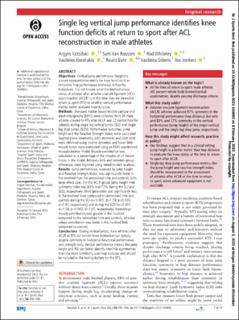| dc.contributor.author | Kotsifaki, Argyro | |
| dc.contributor.author | Van Rossom, Sam | |
| dc.contributor.author | Whiteley, Rod | |
| dc.contributor.author | Korakakis, Vasileios | |
| dc.contributor.author | Bahr, Roald | |
| dc.contributor.author | Sideris, Vasileios | |
| dc.contributor.author | Jonkers, Ilse | |
| dc.date.accessioned | 2022-08-04T11:47:17Z | |
| dc.date.available | 2022-08-04T11:47:17Z | |
| dc.date.created | 2022-05-23T13:03:30Z | |
| dc.date.issued | 2022 | |
| dc.identifier.citation | British Journal of Sports Medicine. 2022, 56(9), Side 490-498. | en_US |
| dc.identifier.issn | 0306-3674 | |
| dc.identifier.uri | https://hdl.handle.net/11250/3010152 | |
| dc.description | This is an open access article distributed in accordance with the Creative Commons Attribution 4.0 Unported (CC BY 4.0) license, which permits others to copy, redistribute, remix, transform and build upon this work for any purpose, provided the original work is properly cited, a link to the license is given, and indication of whether changes were made. | en_US |
| dc.description.abstract | Objectives: Vertical jump performance (height) is a more representative metric for knee function than horizontal hop performance (distance) in healthy individuals. It is not known what the biomechanical status of athletes after anterior cruciate ligament (ACL) reconstruction (ACLR) is at the time they are cleared to return to sport (RTS) or whether vertical performance metrics better evaluate knee function.
Methods: Standard marker-based motion capture and electromyography (EMG) were collected from 26 male athletes cleared to RTS after ACLR and 22 control healthy subjects during single leg vertical jumps (SLJ) and single leg drop jumps (SLDJ). Performance outcomes, jump height and the Reactive Strength Index, were calculated. Sagittal plane kinematics, joint moments and joint work were obtained using inverse dynamics and lower limb muscle forces were computed using an EMG-constrained musculoskeletal model. Muscle contribution was calculated as a percentage of the impulse of all muscle forces in the model. Between-limb and between-group differences were explored using mixed models analyses.
Results: Jump performance, assessed by jump height and Reactive Strength Index, was significantly lower in the involved than the uninvolved limb and controls, with large effect sizes. For the ACLR group, jump height limb symmetry index was 83% and 77% during the SLJ and SLDJ, respectively. Work generation was significantly less in the involved knee compared to uninvolved limb and controls during the SLJ (p<0.001; d=1.19; p=0.003, d=0.91, respectively) and during the SLDJ (p<0.001; d=1.54; p=0.002, d=1.05, respectively). Hamstrings muscle contribution was greater in the involved compared to the uninvolved limb and controls, whereas soleus contribution was lower in the involved limb compared to controls.
Conclusions: During vertical jumps, male athletes after ACLR at RTS still exhibit knee biomechanical deficits, despite symmetry in horizontal functional performance and strength tests. Vertical performance metrics like jump height and RSI can better identify interlimb asymmetries than the more commonly used hop distance and should be included in the testing battery for the RTS. | en_US |
| dc.language.iso | eng | en_US |
| dc.subject | anterior cruciate ligament | en_US |
| dc.subject | injury prevention | en_US |
| dc.subject | knee injuries | en_US |
| dc.subject | sports | en_US |
| dc.subject | ACL | en_US |
| dc.title | Single leg vertical jump performance identifies knee function deficits at return to sport after ACL reconstruction in male athletes | en_US |
| dc.type | Peer reviewed | en_US |
| dc.type | Journal article | en_US |
| dc.description.version | publishedVersion | en_US |
| dc.rights.holder | © Author(s) (or their employer(s)) 2022 | en_US |
| dc.source.pagenumber | 490-498 | en_US |
| dc.source.volume | 56 | en_US |
| dc.source.journal | British Journal of Sports Medicine | en_US |
| dc.source.issue | 9 | en_US |
| dc.identifier.doi | 10.1136/bjsports-2021-104692 | |
| dc.identifier.cristin | 2026519 | |
| dc.description.localcode | Institutt for idrettsmedisinske fag / Department of Sports Medicine | en_US |
| cristin.ispublished | true | |
| cristin.fulltext | original | |
| cristin.qualitycode | 2 | |
